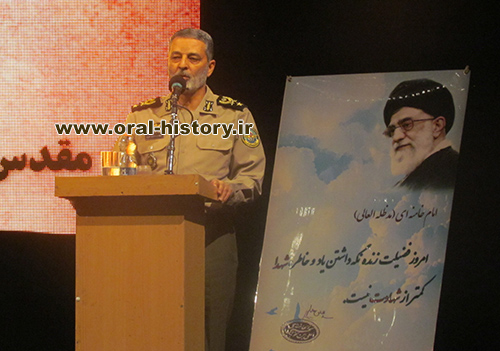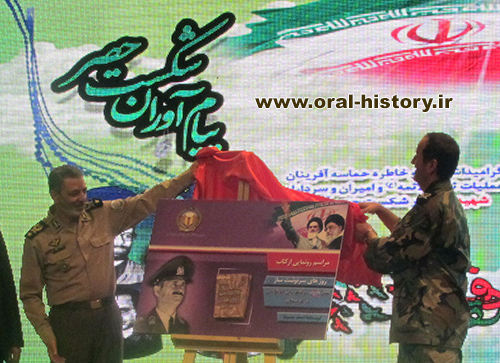The Operation which ensured victory
Maryam Rajabi
Translated by Natalie Haghverdian
2016-10-10
According to Iran Oral History Site, the Conference of "Honoring the memory of heroes of Samen-ol-A'emeh Operation and martyr commanders who are messenger Abadan siege break" was held on Monday evening, 26 September 2016, Andisheh Hall of the art department.
Majority of the guests at the conference were families of the martyrs of the Sacred Defense; first Brigadier General II, Dr. Ibrahim Golfam, the head of the Preservation and Publication of the Values of the Sacred Defense of the Army of the Islamic Republic of Iran and then General Seyed Abdul Rahim Mousavi, deputy chief of the General Staff of the Armed Forces rendered their speeches.
Fateful Days
Brigadier Golfam said: “September 26 is the proud anniversary of Samen-ol-A’emeh Operation and the Memorial Day coincides with the anniversary of this epic operation. A few months after the dismissal of Bani Sadr, the Army and Sepah were united and according to the decree issued by Imam Khomeini, who had commanded that siege of Abadan must be broken a proper plan was devised and on this day the operation broke the siege of Abadan. We shall appreciate the military heroes of Division 77, Sepah forces, public troops (Jihad & Basij) and the infantry, air forces and marines who realized the command of Imam by their unity in this large-scale operation. Today (26 September 2016), in the calendar of the Holy Defense is recorded in the name of the veterans and warriors and heroes of the Holy Defense, whom we honor and there is no doubt that a number of these veterans are here with us today."

He added: “martyr Fallahi, the highest ranking army authority in the Islamic Republic of Iran who was appointed as the Commander in Chief of the Forces for couple of months by Imam, martyr Namjou, Minister of Defense, martyr Fakouri who was Defense Minister for a while and then appointed as the Commander of air forces, martyr Kolahdouz, Deputy Commander of Sepah Forces and martyr Jahan Ara, Commander of Sepah Forces in Khorramshahr were all part of Samen-ol-A’emeh operation. The operation was a victory and two days later on 28 September 1981 they set out to Tehran to deliver the news of Abadan liberation, and it was when they were martyred. In the past two years, we organized a commemoration for the heroes of Samen-ol-A’emeh operation and high ranking commanders of the armed forces of the Islamic Republic of Iran in their place of martyrdom in the vicinity of Tehran in the district of Kahrizak; however, it was felt that these programs do not fully honor the memory of martyrs, heroes and veterans and their sacrifices. Last year, it was decided that we will hold the program in Kahrizak and the first conference as we are here today, was designed to commemorate and appreciate these heroes and the conference was titled “Messengers of Abadan Siege Break”. God willing, we hope that we will be able to hold this conference once in a year to commemorate commanders of armed forces, army, Sepah and Ministry of Defense.”
Brigadier Golfam, then, expressed his gratitude and acknowledged the efforts of the sponsors and said: “The executive session for this program was held two months back where representatives of various organizations were present and we made efforts to involve all and I would like to express my deepest gratitude; Ministry of Communication and Information Technology, Ministry of Culture & Islamic Guidance, Ministry of Defense & Armed Forces Logistics, Revolutionary Guards of the Islamic Republic of Iran, IRIB of the Islamic Republic of Iran, Municipality of Tehran, Tehran City Council, Islamic Advocacy Organization, Art Division that allocated Andisheh Hall to us. Grand Tehran Disciplinary Forces, Foundation of Martyrs and Veterans’ Affairs, Hekmat Iranian Bank, Post, Ideological, political and military security and intelligence agencies, Army Chief of Staff and Technology and Information Departments, etc… and I would like to express my gratitude to the Commanders of the Islamic Republic of Iran who assisted and supported us in our endeavor.
He stated two other activities for the Conference of “Messengers of Abadan Siege Break” and added: One of them is book launch of “Fateful Days”, which is recently published by Preservation and Publication of the Values of the Sacred Defense. The first volume is dedicated to martyr Fallahi who in fact recounts the difficult days after the victory of the Islamic Revolution. Actions of this martyr in defending the Islamic Revolution during the first years and months of the victory of the Islamic Revolution are reflected in this book. Another activity for this conference is the launch of “Five Martyrs” Stamp and we have invited the families of these martyrs and also the martyrs of the Army of the Islamic Republic of Iran. Also, four veterans will receive awards and trophies from the Commander in Chief of the Armed Forces of the Islamic Republic of Ian.”
The Big Step in Army & Sepah Solidarity
Then, Brigadier Seyed Abdolrahim Mousavi, Deputy Chief of the Armed Forces rendered his speech about Samen-or-A’emeh operation and said: Imam was the Commander of All Forces and obviously would issue decrees; however, Abadan was the only place that he specifically insisted that its siege had to be broken. Now, when I look back to the operation and its consequences during the Holy Defense I realize the importance of the decree. Once we see the efforts and sacrifice of the soldiers of Islam from the highest to the lowest ranks to realize Imam’s decree we realize that this was one of the main features of the Holy Defense.

He added: ‘Once the operation was rewarded with victory, the main reason of happiness and celebration for the soldiers was that they had realized Imam’s decree and this is important. This operation was the first big step in solidarity of the Army and Sepah which revolutionized the country. The other aspect of the operation was its strategic effect on the Iraq imposed war against Iran and any further cunctation or had we failed in our effort to liberate and break the siege, Abadan and all the people and all forces inside would succumb to the enemy and the path of war would change.”
He continued by saying: “the other aspect was the type of operation; we were surrounded by the enemy and design and steering and control of the operation under such circumstances is very difficult. However, we had informed experts among us and with proper operation design we succeeded. The most important issue is that our success in this operation steered us to the path of victory; two months later we had Bostan Liberation Operation and two months after, Fath-ol-Mobin operation and then liberation of Khorramshahr. We were in the loop of victory and the enemy was in the loop of defeat.”

He said: “There are turning points in every individual or community’s life which writes their destiny. It is an ultimatum for the said individual or community and I believe that if we had these five martyrs (Fallahi, Namjou, Fakouri, Kolahdouz and Jahan Ara) we had it all. They had all optimum values to steer a nation to the highest level of humanity and in case of default or failure we have no excuse to justify our actions to God.”
Commander in Chief Seyed Abdolrahim Mousavi also offered memories of these five martyrs. He said about the heroic actions of martyr Fallahi and the fact that martyr Fakouri, at the beginning of the Islamic Revolution, once the enemy had invaded the armed bases of Iran, used his tactical knowledge to immediately retaliate. Or the fact that martyr Namjou was a spiritual person, he was a planner; he was a scientist with military strength and in the battlefield he was a furious military commander.
There was also martyr Kolahdouz; these martyrs were determined to protect the military strength of the country; hence they established Sepah at the same time and they made huge sacrifices and martyr Jahan Ara joined the forces when he was 15 and pursued his defense as an expert, knowledgeable and serious person.

At the end of the first conference, “Fateful Days” written by Ahmad Hossein Nia about Brigadier Martyr Fallahi and the Commemorative stamp of five martyrs were launched. Also, families of some of the martyrs received awards and trophies in commemoration of their martyrs.
Number of Visits: 5804
http://oral-history.ir/?page=post&id=6641
